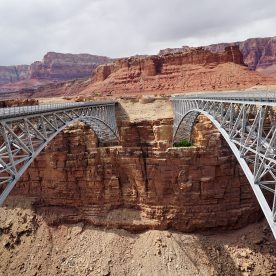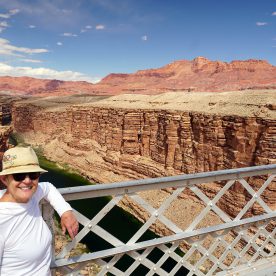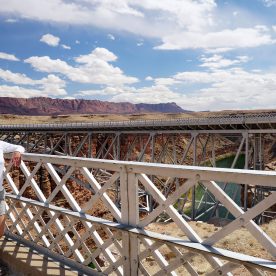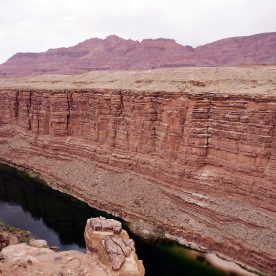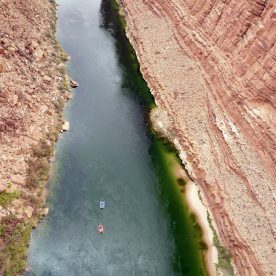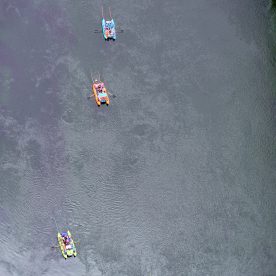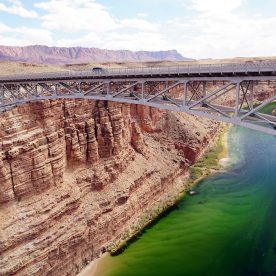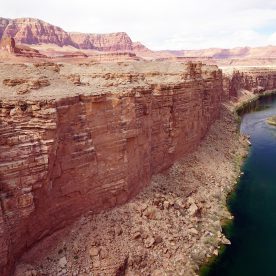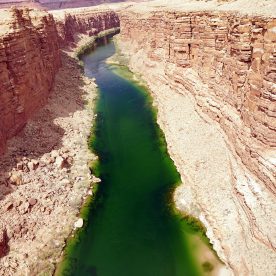Construction of the original Navajo Bridge began in 1927, and the bridge opened to traffic in 1929. The bridge was paid for by the nascent Arizona State Highway Commission (now the Arizona Department of Transportation) in cooperation with the United States Department of the Interior’s Bureau of Indian Affairs, as the eastern landing is on the Navajo Nation. The steel spandrel bridge was designed and constructed by the Kansas City Structural Steel Company. During construction, worker Lane McDaniel died after falling 470 feet (140 m) to the Colorado River below. Supervisors had rejected the idea of rigging safety netting, believing that it would catch on fire from falling hot rivets.
The original bridge is 834 feet (254 m) in length, with a maximum height of 467 feet (142 m) from the canyon floor. The roadway offers an 18-foot (5.5 m) surface width with a load capacity of 22.5 tons (although the posted legal weight limit was 40 tons). During the design phase, a wider roadway was considered, but ultimately rejected, as it would have required a costly third arch to be added to the design, and the vehicles of the time did not require a wider road. When the Bridge officially opened on January 12, 1929, the Flagstaff paper proclaimed it “the biggest news in Southwest history.”
By 1990, however, officials decided that the traffic flow was too great for the original bridge and that a new solution was needed. The sharp corners in the roadway on each side of the approach had become a safety hazard due to low visibility, and deficiencies resulting from the original design’s width and load capacity specifications were becoming problematic. The bridge had also become part of US 89A.
A view of the bridges and Marble Canyon from the Colorado River, September 2009
Deciding on a solution was difficult, due to the many local interests. Issues included preservation of sacred Navajo land, endangered plant species in Marble Canyon, and the possibility of construction debris entering the river. The original proposal called for merely widening and fortifying the bridge, but this was ultimately rejected as not able to meet contemporary federal highway standards. Replacement became the only option, and it was eventually decided to entirely discontinue vehicular traffic on the original bridge. A new bridge would be built immediately next to the original and have a considerably similar visual appearance, but would conform to modern highway codes.
The new steel arch bridge was commissioned by the Arizona Department of Transportation and the Federal Highway Administration, and was completed in May 1995, at a cost of $14.7 million. A formal dedication was held on September 14, 1995.
The original Navajo Bridge is still open to pedestrian and equestrian use, and an interpretive center has been constructed on the west side to showcase the historical nature of the bridge and early crossing of the Colorado River. The original bridge has been designated as a Historic Civil Engineering Landmark, and was placed on the National Register of Historic Places on August 13, 1981.
California condors were reintroduced to the area in 1996 and can sometimes be seen in the at Navajo Bridge.
Original bridge (1929)
Sign on original bridge with figures, March 2016
Total length: 834 feet (254 m)
Steel arch length: 616 feet (188 m)
Arch rise: 90 feet (27 m)
Height above river: 467 feet (142 m)
Width of the roadway: 18 feet (5.5 m)
Amount of steel: 2,400,000 pounds (1,100,000 kg)
Amount of concrete: 500 cubic yards (382 m3)
Amount of steel reinforcement: 82,000 pounds (37,000 kg)
Construction cost: $390,000 (equivalent to $5.81 million in 2019)
New bridge (1995)
Car crossing the new Navajo Bridge (U.S. Route 89A), April 2009
Total length: 909 feet (277 m)
Steel arch length: 726 feet (221 m)
Arch rise: 90 feet (27 m)
Height above river: 470 feet (143 m)
Width of the roadway: 44 feet (13 m)
Amount of steel: 3,900,000 pounds (1,800,000 kg)
Amount of concrete: 1,790 cubic yards (1,370 m3)
Amount of steel reinforcement: 434,000 pounds (197,000 kg)
Construction cost $14.7 million (equivalent to $24.66 million in 2019)
